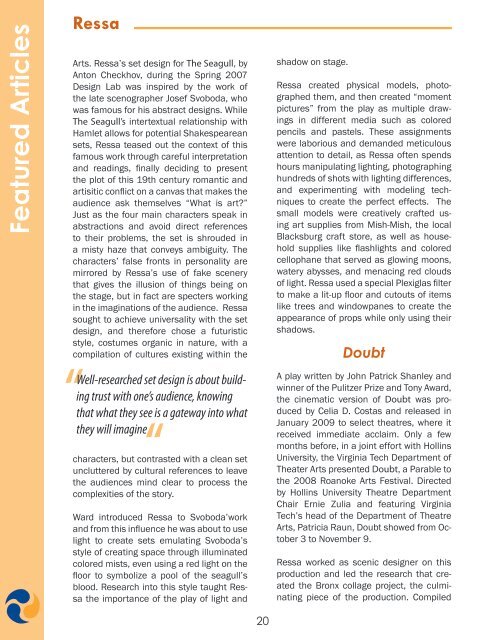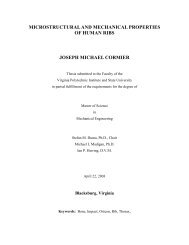Research Articles - VTechWorks - Virginia Tech
Research Articles - VTechWorks - Virginia Tech
Research Articles - VTechWorks - Virginia Tech
Create successful ePaper yourself
Turn your PDF publications into a flip-book with our unique Google optimized e-Paper software.
Featured <strong>Articles</strong><br />
Ressa<br />
Arts. Ressa’s set design for The Seagull, by<br />
Anton Checkhov, during the Spring 2007<br />
Design Lab was inspired by the work of<br />
the late scenographer Josef Svoboda, who<br />
was famous for his abstract designs. While<br />
The Seagull’s intertextual relationship with<br />
Hamlet allows for potential Shakespearean<br />
sets, Ressa teased out the context of this<br />
famous work through careful interpretation<br />
and readings, finally deciding to present<br />
the plot of this 19th century romantic and<br />
artisitic conflict on a canvas that makes the<br />
audience ask themselves “What is art?”<br />
Just as the four main characters speak in<br />
abstractions and avoid direct references<br />
to their problems, the set is shrouded in<br />
a misty haze that conveys ambiguity. The<br />
characters’ false fronts in personality are<br />
mirrored by Ressa’s use of fake scenery<br />
that gives the illusion of things being on<br />
the stage, but in fact are specters working<br />
in the imaginations of the audience. Ressa<br />
sought to achieve universality with the set<br />
design, and therefore chose a futuristic<br />
style, costumes organic in nature, with a<br />
compilation of cultures existing within the<br />
Well-researched set design is about building<br />
trust with one’s audience, knowing<br />
that what they see is a gateway into what<br />
they will imagine<br />
characters, but contrasted with a clean set<br />
uncluttered by cultural references to leave<br />
the audiences mind clear to process the<br />
complexities of the story.<br />
Ward introduced Ressa to Svoboda’work<br />
and from this influence he was about to use<br />
light to create sets emulating Svoboda’s<br />
style of creating space through illuminated<br />
colored mists, even using a red light on the<br />
floor to symbolize a pool of the seagull’s<br />
blood. <strong>Research</strong> into this style taught Ressa<br />
the importance of the play of light and<br />
20<br />
shadow on stage.<br />
Ressa created physical models, photographed<br />
them, and then created “moment<br />
pictures” from the play as multiple drawings<br />
in different media such as colored<br />
pencils and pastels. These assignments<br />
were laborious and demanded meticulous<br />
attention to detail, as Ressa often spends<br />
hours manipulating lighting, photographing<br />
hundreds of shots with lighting differences,<br />
and experimenting with modeling techniques<br />
to create the perfect effects. The<br />
small models were creatively crafted using<br />
art supplies from Mish-Mish, the local<br />
Blacksburg craft store, as well as household<br />
supplies like flashlights and colored<br />
cellophane that served as glowing moons,<br />
watery abysses, and menacing red clouds<br />
of light. Ressa used a special Plexiglas filter<br />
to make a lit-up floor and cutouts of items<br />
like trees and windowpanes to create the<br />
appearance of props while only using their<br />
shadows.<br />
Doubt<br />
A play written by John Patrick Shanley and<br />
winner of the Pulitzer Prize and Tony Award,<br />
the cinematic version of Doubt was produced<br />
by Celia D. Costas and released in<br />
January 2009 to select theatres, where it<br />
received immediate acclaim. Only a few<br />
months before, in a joint effort with Hollins<br />
University, the <strong>Virginia</strong> <strong>Tech</strong> Department of<br />
Theater Arts presented Doubt, a Parable to<br />
the 2008 Roanoke Arts Festival. Directed<br />
by Hollins University Theatre Department<br />
Chair Ernie Zulia and featuring <strong>Virginia</strong><br />
<strong>Tech</strong>’s head of the Department of Theatre<br />
Arts, Patricia Raun, Doubt showed from October<br />
3 to November 9.<br />
Ressa worked as scenic designer on this<br />
production and led the research that created<br />
the Bronx collage project, the culminating<br />
piece of the production. Compiled



